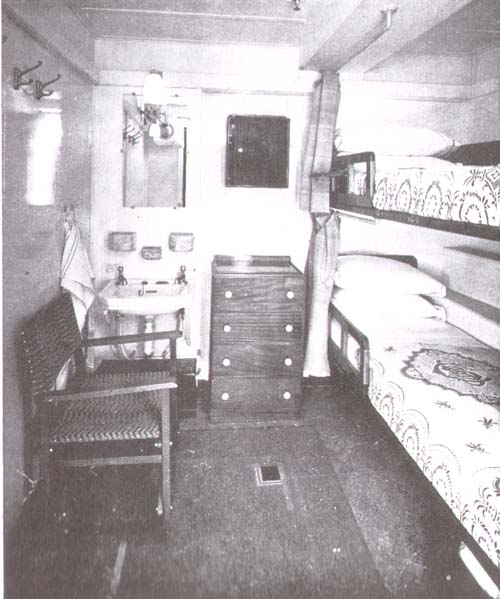
According to the Shipbuilder:
"While providing for fewer numerically in the third-class accommodation than has been the general practice in former vessels for the North Atlantic, advantage had been taken to increase considerably the space per passenger, and throughout the staterooms there is not the slightest suggestion of overcrowding.
The staterooms are of the two and four-berth types, furnished with mahogany bedsteads of a simple yet pleasing design and provided with spring-interior type mattresses. Where upper berths are fitted these are of a folding Pullman type.

Typical Third Class Cabin
Built-in wardrobes in polished hardwood are provided, together with fitted dressing tables and comfortable chairs and stools. The chairs are upholstered in worsted uncut moquette woven by Messrs. John Holdsworth & Co., Ltd.
The washbasins in each staterooms, ventilation is on the Thermotank supply system, with adjustable louver in each room, while each stateroom is further provided with an electric fan.
Electric-light fittings are placed over the washbasins and over each individual berth, the last-named fittings being arranged to give a direct downward beam for comfort when reading in bed, without disturbing other passengers in the room.
Flush paneled walls and cased ceilings in various decorative finishes are adopted throughout the third-class staterooms, while the doors and architraves are of polished bleached oak. The floors are covered in Korkoleum, ½ in. in thickness and purple marble in colour, and port curtains and bedside rugs in pleasant tones of grey, blue and orange complete the effect of quiet comfort.
The stateroom corridors have a dado in bleached oak, with hardwood pilasters at intervals interspersed with painted panels. The ceilings in the corridors are flush-fitted throughout."
History of Use
1936 – 1939
- we are unaware of any significant changes made to these facilities as described above during this period.1940 – 1946 - the ship was used as a troop transport during this period. The precise functions assigned to the third-class cabins is currently being researched.
1947 – 1967 - the paneling and the furnishing were meticulously restored in the post war refit. The third-class cabins returned to their original use. As the passenger load changed during the late 1950s and early 1960s some first-class cabins in the forward part of A deck were rebuilt and reassigned to third-class use. In 1947 third-class was renamed tourist class.
1968 – present – because of their small size and lack of private bathrooms, the third-class cabins were considered unsuitable for use as upscale modern hotel rooms. And in the years before "Upstairs, Downstairs" the attraction developers had little interest preserving either crew quarters or third-class cabins. (By 1967 there were third-class cabins on A through D decks on the Queen Mary.) All of the third-class cabins throughout the entire Queen Mary were removed.
A model of a single third-class cabin along with a second-class cabin and a model of a first-class suite were built in the former third class smoking room on A deck as part of an "exhibit" on passenger and crew accommodations on the ship. This exhibit has since been moved to a former mail handling area on B deck forward.
The area where most third class cabins were originally located – the forward and starboard side of C and D decks are now storage and engineering/building maintenance areas.
Restoration and/or Reuse Potential
With the construction of adequate facilities for storage and maintenance on the property but off the ship we see the potential for reconstructing of a section of third class cabins and associated facilities, (corridors, bathroom facilities), in a portion of C deck forward area of the ship for the following revenue generating purposes:
![]() Return
to
Index by Deck
Return
to
Index by Deck
![]() Return
to
Home Page Index
Return
to
Home Page Index